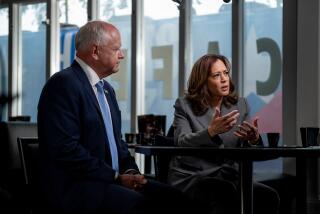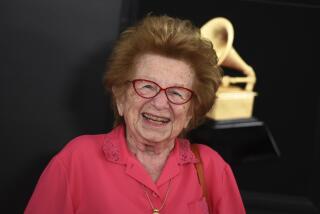‘Dr. Laura’s’ New TV Show Gets Lukewarm Reception
- Share via
Controversy didn’t translate into big ratings for the premiere of “Dr. Laura,” the syndicated talk show hosted by radio personality Laura Schlessinger that has spurred protests due to past statements by the host regarding homosexuality.
“Dr. Laura” attracted just 2% of homes Monday in 46 major cities accounting for more than half the U.S. population, based on data from Nielsen Media Research. That rating is below the average for programs leading into the show in those markets as well as what the same stations averaged in the time slot a year ago.
By contrast, “The Oprah Winfrey Show”--which featured an interview with Democratic presidential nominee Al Gore and played opposite “Dr. Laura” in several key cities, including Los Angeles and New York--was watched in 5.6% of homes, a 27% increase compared to its season premiere last year.
Daytime’s other big talk entry, “The Rosie O’Donnell Show,” was viewed in 3.1% of homes, a slight drop versus the corresponding period in 1999.
As for Schlessinger’s home base of Los Angeles (the program is taped in Canoga Park), “Dr. Laura” ranked sixth among eight local stations measured by Nielsen, viewed in 85,000 households, or 1.6% of homes in the area. Winfrey, by contrast, attracted almost 360,000 homes (6.7%) and O’Donnell reached 145,000 (2.7%) during the same hour.
Beyond lukewarm ratings, pressure by gay-rights activists clearly took a toll on the quality of “Dr. Laura’s” advertising support.
Few of the national sponsors normally seen on daytime television appeared during the program, which instead featured a glut of direct-response commercials--marketing such items as a dietary product and a Shirley Temple video collection--as well as local ads. Such sponsors normally pay far lower rates than top national advertisers.
Seeking to avoid controversy, several major companies--among them Procter & Gamble and Sears--have pledged not to advertise during the show.
“Most of [the sponsors] are no-names,” said John Aravosis, an organizer of StopDrLaura.com, the campaign targeting those who sponsor Schlessinger’s radio and television show. “We’ll go after the best-known companies first.”
StopDrLaura.com is posting the program’s sponsors on its Web site and urging supporters to boycott local advertisers in their cities. A few companies whose ads ran during the show Monday, including Bally Total Fitness and Verizon, have already told the online group they would no longer support the show.
Such economic protests--in the past usually directed by conservative groups against risque programs such as “NYPD Blue”--have rarely been successful in getting a popular program taken off the air, but they may hasten the demise of low or marginally rated shows. Public protests were staged in various cities Monday, including one outside the Paramount lot in Hollywood.
The studio, which has kept relatively quiet leading up to this week’s premiere, issued a statement saying, “We believe that Dr. Laura, with her substantial radio audience, will be a part of the TV landscape for the long haul. We are producing a responsible, substantive program and believe viewers will tune in to her unique approach to issues as they relate to family, parenting and the community.”
A Paramount spokesman also noted that “Dr. Laura” drew a higher rating than three other daytime series introduced Monday, including two courtroom shows, “Curtis Court” and “Judge Hatchett,” and a “relationship” show titled “House Calls.” Those programs, however, generally don’t occupy the same high-profile time periods generally afforded “Dr. Laura.”
More to Read
The complete guide to home viewing
Get Screen Gab for everything about the TV shows and streaming movies everyone’s talking about.
You may occasionally receive promotional content from the Los Angeles Times.






